This website uses cookies so that we can provide you with the best user experience possible. Cookie information is stored in your browser and performs functions such as recognising you when you return to our website and helping our team to understand which sections of the website you find most interesting and useful.
The Role of IoT in the Future of Urban Farming
The Internet of Things (IoT) is rapidly reshaping the way urban farming operates, driving smarter, more productive, and sustainable food cultivation within cities. Urban farming itself addresses crucial challenges like limited space and the need for local, fresh produce, but when coupled with IoT, the possibilities expand significantly. IoT integrates networks of sensors, data analytics, and automation to revolutionize every stage of food production, from planting to harvest. This synergy between advanced technology and urban agriculture presents a promising vision for sustainable cities, food security, and resource efficiency. In the following sections, we will explore the multifaceted role IoT is set to play in the evolution of urban farming.

Enhancing Precision in Urban Agriculture

Increasing Yields While Promoting Sustainability



